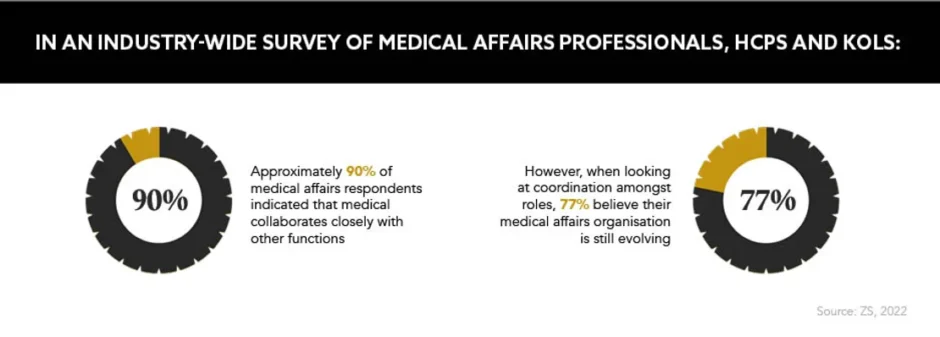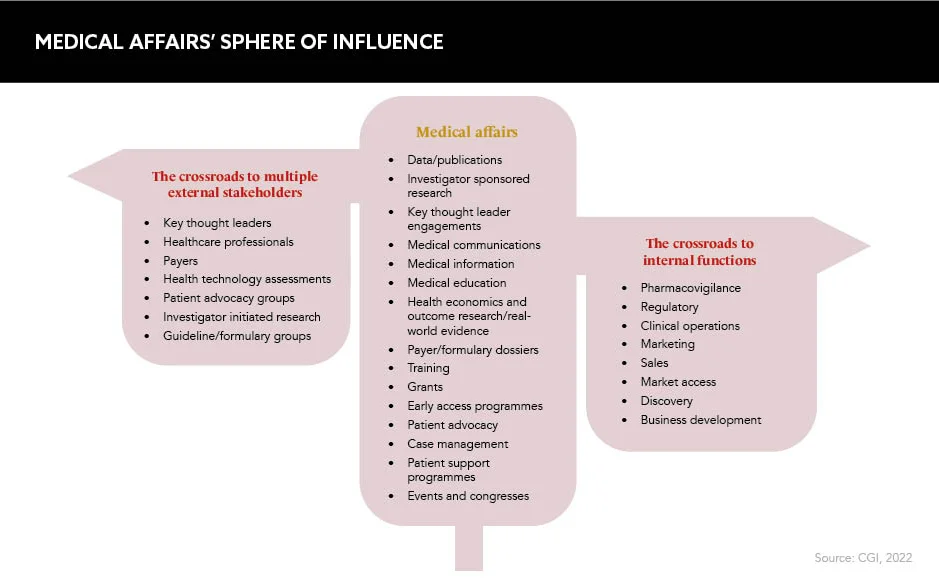Historically, the purpose and value of medical affairs has been poorly understood and inadequately measured by wider pharma organisations. As its responsibilities grow, how can companies ensure appreciation and tracking of its value coincide with this progress?
Words by Isabel O’Brien
If you were to ask a medical affairs professional whether their value has always been properly understood within their organisation, the answer would likely be no. In the last 20 years, the function has evolved at a lightening pace, but, with this in mind, recognition of its value has, in some cases, been known to lag.
If various industry predictions are to be believed, medical affairs’ scope is only set to expand further in the future, so why has its value been underestimated in the past? And how can it toot its own horn with more gusto to ensure its value is unlocked and recognised by all functions from pharma’s grassroots to the C-suite?
The early days
While MA is now highly specialised, rigorously scientific and has a diverse set of responsibilities, this has not always been the case. The Medical Science Liaison (MSL) role dates back nearly five decades – having been founded at Upjohn Company in 1967 – and early MSL teams were primarily sales reps with scientific backgrounds who had moved over to this new-fangled function.
Its duties, too, were very different, limited to supporting sales teams in compliantly commercialising medicines. This was “mainly through medical education, medical information and review of promotional materials”, notes Luisa Luciani-Silverman, US Medical Head, Immuno-Oncology, Lung, AstraZeneca. This certainly demonstrates the extent to which the function has developed, but also how it was designed as a supportive arm rather than a valuable department in its own right.
The function’s scope is only set to expand further in the future
A turning point was marked when companies began to require candidates to have doctorates to join MA departments in the 1980s. As Dr Samin Saeed, Former UK Chief Scientific Officer and Medical Director, Novartis UK, speaking on The GOLD Podcast, points out: “When you’re recruiting people with these backgrounds, you want them to do more than just sign off materials and do the quality checking.” Raising the bar for entry into the medical function in this way created buckets of potential for impact, but it still took time for the function’s responsibilities to catch up with the expertise flooding in.
“When I first joined, medical were still seen as there to provide medical accuracy, particularly for the commercial side of things,” continues Dr Saeed, echoing Luciani-Silverman’s observation. This presented an issue for two reasons: first, MA professionals were at risk of feeling frustrated by the work available, and second, it reduced their ability to directly impact the business outcomes of their organisation.

Breaking the bottleneck
MA departments of the past were stuck in a value demonstration bottleneck as they were largely enabling commercial colleagues to achieve their goals while lacking avenues to impact outcomes on their own. Offering one example, Dr Luca Dezzani, Vice President, US Oncology Medical Affairs, Johnson & Johnson, explains: “Many years ago, we were not doing a lot of data generation and real-world evidence, therefore there wasn’t a lot we could claim to be doing when it came to furthering knowledge about how a medicine was impacting a patient’s life or in helping to change things like guidelines or clinical practice.”
In addition, value measurement metrics were seemingly not up to scratch. “Some 20 years ago, the KPIs and metrics we had for measuring medical affairs activities were very much based on activity and volume rather than impact and value,” Dr Dezzani adds. These metrics were in line with those typically used by commercial teams and failed to represent the qualitive impact of the function.
When I first joined, medical were seen as there to sign off materials and to provide the medical accuracy
As science has flourished over the last two decades – this period has been particularly pivotal for cell and gene therapies as 2,335 clinical trials were completed between 1989 and 2015 – the need for expert scientific communicators has grown exponentially. “As new technologies have accelerated and made the science more complex, MA’s multifaceted expertise has become more and more relevant along the whole product lifecycle,” explains Luciani-Silverman, asserting how science and the scope of medical affairs has advanced in tandem.
Now, the role of MA has ballooned to include real-world evidence generation, patient advocacy and identification and other types of external stakeholder engagement, such as liaising with policy makers and payers. As Bora Erdemli, Associate Principal and Leader, Medical Affairs Practice, Europe, ZS, puts it, the function has moved from “full-time custodian of scientific information” to be the “scientific face of the overall organisation”.
Having raced from data disseminator to communicator and now insight collector to insight generator, MA’s ability to drive value is picking up speed, and the potential is palpable. “The real transition is medical affairs moving from being a supportive function to co-leading the strategy together with other functions,” notes Dr Dezzani.
A new chapter
While MA has largely broken free from pigeonholing by companies, the next logical step must be to highlight its multifaceted value delivery to the other functions and the all-important C-suite. “The key is not only relying on communicating the value,” says Erdemli, “but also enabling people to feel and experience its impact.” Recognition has lagged in the past, not just in commercial but in clinical development and R&D too, and storytelling is crucial to ensuring its value is illustrated coherently. In Erdemli’s view, there’s a clear trajectory: MA must start making waves internally and demonstrate its impact on its organisation’s business outcomes, then it must show how it is impacting the healthcare ecosystem and patients.
Exploring the measurement of external value specifically, the ZS ‘Medical Affairs Outlook Report 2022’ identifies three core areas for MA to focus on. It reveals that two-thirds of key opinion leaders (KOLs) believe MA’s ability to drive deep scientific conversations on real-world evidence, health outcomes and economic value are its key value indicators of the future.
Recent digital transformation will be useful for meeting these objectives. According to Veeva Systems data, from April 2020 to June 2021, medical reps globally scheduled 214,000 virtual meetings with HCP clients, and these meetings lasted 40% longer than traditional meetings, producing roughly eight million additional minutes of engagement. As analytics become more advanced, they will become crucial to medical’s value demonstration strategy, including to link patient outcomes data to MA’s efforts.
Keep accelerating
MA’s move into creating and demonstrating value has been substantial, but it must not become idle in its evolution journey. “The environment itself is getting more complex, and this requires medical affairs to step up,” says Dr Saeed. “We need to hold hands as a cross-functional team and figure out how we get very complicated medicines into complicated disease areas or to patients you can’t readily identify.”
While Saeed acknowledges that the MA voice has grown louder and stronger over recent years, she still believes there is a way to go. And Dr Dezzani agrees, adding: “More work needs to be done when it comes to upskilling medical affairs colleagues from a business acumen standpoint to ensure teams are fit for the future.” As a majority of MA professionals are now joining the function from medical- and research-based backgrounds, companies should be supporting new recruits to undertake business qualifications such as MBAs, or simply encouraging them to immerse themselves within other functions to achieve a comprehensive understanding of how business meets science in the industry.
The future
In the past, the value of MA was underestimated at best, and at worse misunderstood, due to a lack of opportunity to impact outcomes and a reduced visibility of the value it creates. Still, by all accounts, it is on a speedy course to become one of the most influential functions in pharma, helped along the way by factors such as the ever-growing complexity of science and measurement hacks offered by digital transformation.
The picture is a positive one, but Luciani-Silverman poses a final point of consideration: “The maturity and organisation of medical affairs teams varies from company to company.” It is therefore vital for organisations to pinpoint where their teams sit on the MA evolution timeline to identify if they are lagging, excelling or sitting somewhere in between – only then can they progress swiftly and smoothly to optimise this instrumental function.
Pharmaceutical organisations have a Ferrari in their multi-car garage and they are driving it to do the grocery shopping
“From the organisational perspective, misunderstanding can create a vicious cycle where medical never has the appropriate talent or the resources to elevate its impact,” adds Erdemli. He believes MA has great potential to help companies triumph over competitors and improve patient outcomes, but that it’ll be limited without the right investment in people or resources. Overall, though, there is optimism about what lies ahead.
“Imagine a future where healthcare ecosystem partners, including pharmaceutical companies, are incentivised based on patient outcomes versus volume of sales and revenue growth,” Erdemli concludes. “Today, pharmaceutical organisations have a Ferrari in their multi-car garage – MA – and they are driving it to do the grocery shopping.” The potential is hitting fever pitch, it just needs to be unlocked by high-value delivery, understanding and quantification.
Case study
Bora Erdemli, Associate Principal and Leader, Medical Affairs Practice, Europe, ZS, discusses the risks involved when companies misunderstand the true value of MA
Let’s think about a scenario in which a pharmaceutical organisation is planning a launch of an innovative treatment with a novel mechanism of action. If this is an organisation where MA is misunderstood, this typically means that they are also underfunded or resourced.
This leads to sub-optimal communication with the key opinion leaders and broader scientific or medical community. Then, physicians either don’t have enough information or evidence and don’t have a way to make informed decisions for their patients. As a result, there is a risk of patients who may get on this life-changing therapy late or not get on it at all, leading to poor health outcomes or even potential lives lost.
Luckily, in an organisation where the value of MA is properly understood, these adverse events can be avoided as the function will be able to effectively engage with external stakeholders to identify and support patients in need.










